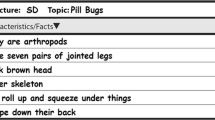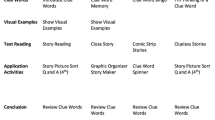Abstract
Expository writing may be especially difficult for elementary grade students due to lack of background knowledge and unfamiliar text structures. A text structure writing intervention aimed at teaching students to write informational text using text structures has been shown to have promise for improving the informational text writing of upper elementary grade students using small group instruction (Reading and Writing, 31, 2115–2145; Reading and Writing: An Interdisciplinary Journal, 31, 2165–2190; Learning Disabilities: A Multidisciplinary Journal, 23, 35–55. ). There are disadvantages to small group instruction, however, because it requires additional resources. In the current study, 41 students in grade 4 were randomly assigned to receive the Structures Writing intervention or BAU narrative writing instruction. Both groups received instruction in a large group setting. At posttest, students who received the Structures Writing intervention statistically significantly outperformed the control group on researcher-created measures of simple description, compare/contrast, sequence, problem–solution, and cause-effect writing. Results indicated no differences between on distal reading outcomes. The intervention components completed within the allotted time-frame were completed with a high degree of fidelity (97%), providing an indicator of usability. However, students only fully completed 57% of lesson activities, indicating that it is not feasible to complete the lessons within a 30-min time frame. The discussion highlights the Structures Writing intervention as a promising approach for improving informational text writing skills of fourth grade students with moderate to large effect sizes that support findings of a prior pilot test. A larger efficacy trial is warranted following revision of the lessons to shorten lesson duration.

Similar content being viewed by others
References
Hebert, M., Bohaty, J. J., Nelson, J. R., & Lambert, M. C. (2018a). Identifying and discriminating expository text structures: An experiment with 4th and 5th grade struggling readers. Reading and Writing, 31, 2115–2145. https://doi.org/10.1007/s11145-018-9841-x.
Hebert, M., Bohaty, J. J., Nelson, J. R., & Roehling, J. (2018b). Writing informational text using provided information and text structures: An intervention for upper elementary struggling writers. Reading and Writing: An Interdisciplinary Journal, 31, 2165–2190. https://doi.org/10.1007/s11145-018-9841-x.
Hebert, M., Bohaty, J. J., Nelson, J. R., Roehling, J., Christensen, K. (2018c). Taking notes on informational source text using text structures: An intervention for fourth grade students with learning difficulties. Learning Disabilities: A Multidisciplinary Journal, 23, 35–55. https://doi.org/10.18666/LDMJ-2018-V23-I2-9048.
Berninger, V. W., & Amtmann, D. (2003). Preventing written expression disabilities through early and continuing assessment and intervention for handwriting and/or spelling problems: Research into practice. In H. L. Swanson, K. R. Harris, & S. Graham (Eds.), Handbook of learning disabilities (pp. 345–363). Guilford Press.
Breaux, K. C. (2010). Wechsler Individual Achievement Test—third edition: Technical manual. Pearson.
Cohen, J. (1988). Statistic power analysis in the behavioral sciences. Hillsdale, NJ: Erlbaum.
Duin, A. H., & Graves, M. F. (1987). Intensive vocabulary instruction as a prewriting technique. Reading Research Quarterly, 22, 311–330. https://doi.org/10.2307/747971.
Duke, N. K. (2000). 3.6 minutes per day: The scarcity of informational texts in first grade. Reading Research Quarterly, 35, 202–224. https://doi.org/10.1598/RRQ.35.2.1.
Englert, C. S., Mariage, T. V., Okolo, C. M., Shankland, R. K., Moxley, K. D., Courtad, C. A., & Chen, H. Y. (2009). The learning-to-learn strategies of adolescent students with disabilities: Highlighting, note taking, planning, and writing expository texts. Assessment for Effective Intervention, 34, 147–161. https://doi.org/10.1177/1534508408318804.
Gersten, R., Fuchs, L. S., Williams, J. P., & Baker, S. (2001). Teaching reading comprehension strategies to students with learning disabilities: A review of research. Review of Educational Research, 71, 279–320. https://doi.org/10.3102/00346543071002279.
Graham, S. (2018). A revised writer(s) within community model of writing. Educational Psychologist, 53, 258–279. https://doi.org//https://doi.org/10.1080/00461520.2018.1481406
Graham, S., & Harris, K. R. (2003). Students with learning disabilities and the process of writing: A meta-analysis of SRSD studies. In H. L. Swanson, K. R. Harris, & S. Graham (Eds.), Handbook of learning disabilities (pp. 323–344). Guilford Press.
Graham, S., & Hebert, M. (2010). Writing to read: The evidence-base for how writing can improve reading. Washington, DC: Alliance for Excellent Education (Manuscript commissioned by the Carnegie Corporation of New York).
Graham, S., & Perin, D. (2007). Writing next: Effective strategies to improve writing of adolescents in middle and high school: A report to Carnegie Corporation of New York. Washington, DC: Alliance for Excellent Education.
Graham, S., Harris, K., & Hebert, M. (2011). Informing writing: The benefits of formative assessment. Washington, DC: Alliance for Excellent Education (Manuscript commissioned by Carnegie Corporation of New York).
Graham, S., Hebert, M., Sandbank, M. P., & Harris, K. (2016). Credibly assessing the writing achievement of young struggling writers: Application of generalizability theory. Learning Disabilities Quarterly, 39, 72–82. https://doi.org/10.1177/0731948714555019.
Graham, S., Liu, X., Aitken, A., Ng, C., Bartlett, B., Harris, K. R., & Holzapfel, J. (2018). Effectiveness of literacy programs balancing reading and writing instruction: A meta-analysis. Reading Research Quarterly, 53(3), 279–304. https://doi.org/10.1002/rrq.194.
Harris, K. R., Graham, S., & Mason, L. H. (2006). Improving the writing, knowledge, and motivation of struggling young writers: Effects of self-regulated strategy development with and without peer support. American Educational Research Journal, 43, 295–340. https://doi.org/10.3102/00028312043002295.
Hayes, J. (1996). A new framework for understanding cognition and affect in writing. In M. Levy & S. Ransdell (Eds.), The science of writing: Theories, methods, individual differences, and applications (pp. 1–27). Erlbaum & Associates.
Hayes, J. R., & Flower, L. S. (1980). Identifying the organization of writing processes. In L. W. Gregg & E. R. Steinberg (Eds.), Cognitive processes in writing (pp. 3–30). Erlbaum & Associates.
Hebert, M., Bohaty, J. J., Nelson, J. R., & Brown, J. A. (2016). The effects of text structure instruction on expository reading comprehension: A metaanalysis. Journal of Educational Psychology, 108, 609–629. https://doi.org/10.1037/edu0000082.
Hedges, L. V. (1981). Distribution theory for Glass’s estimator of effect size and related estimators. Journal of Educational Statistics, 6, 107–128. https://doi.org/10.2307/1164588.
Kim, A. H., Vaughn, S., Wanzek, J., & Wei, S. (2004). Graphic organizers and their effects on the reading comprehension of students with LD: A synthesis of research. Journal of Learning Disabilities, 37, 105–118. https://doi.org/10.1177/00222194040370020201.
Kim, Y. S. G., Schatschneider, C., Wanzek, J., Gatlin, B., & Al Otaiba, S. (2017). Writing evaluation: Rater and task effects on the reliability of writing scores for children in Grades 3 and 4. Reading and writing, 30, 1287–1310. https://doi.org/10.1007/s11145-017-9724-6.
Klein, P. D., & Kirkpatrick, L. C. (2010). A framework for content area writing: Mediators and moderators. Journal of Writing Research, 2, 1–46. https://doi.org/https://doi.org/10.17239/jowr-2010.02.01.1.
Lipsey, M. W., & Wilson, D. B. (2001). Practical meta-analysis. Sage Publications, Inc.
Mandler, J. M., & Johnson, N. S. (1977). Remembrance of things parsed: Story structure and recall. Cognitive Psychology, 9, 111–151. https://doi.org/10.1016/0010-0285(77)90006-8.
Mason, L. H., Snyder, K. H., Sukhram, D. P., & Kedem, Y. (2006). TWA+ PLANS strategies for expository reading and writing: Effects for nine fourth-grade students. Exceptional Children, 73, 69–89. https://doi.org/10.1177/001440290607300104.
McNeill, K. L., & Berland, L. (2017). What is (or should be) scientific evidence use in k-12 classrooms? Journal of Research in Science Teaching, 54, 672–689.
Meyer, B. J. F. (1985). In B. K. Britton & J. Black (Eds.), Understanding expository text: A theoretical and practical handbook for analyzing explanatory text (pp. 269–304). Erlbaum.
Meyer, B. J., & Rice, G. E. (1984). The structure of text. In P. D. Pearson (Ed.), Handbook of reading research (pp. 319–351). Longman, Inc.
Meyer, B. J., Wijekumar, K., & Lei, P. (2018). Comparative signaling generated for expository texts by 4th–8th graders: Variations by text structure strategy instruction, comprehension skill, and signal word. Reading and Writing, 31, 1937–1968. https://doi.org/10.1007/s11145-018-9871-4.
Persky, H.R., Daane, M.C. and Jin, Y. (2003). The nation’s report card: Writing 2002. (NCES 2003–529). U.S. Department of Education. Institute of Education Sciences. National Center for Education Statistics. Government Printing Office.
Reynolds, G. A., & Perin, D. (2009). A comparison of text structure and self-regulated writing strategies for composing from sources by middle school students. Reading Psychology, 30, 265–300. https://doi.org/10.1080/02702710802411547.
Rogers, L. A., & Graham, S. (2008). A meta-analysis of single subject design writing intervention research. Journal of Educational Psychology, 100, 879–906. https://doi.org/10.1037/0022-0663.100.4.879.
Sáenz, L. M., & Fuchs, L. S. (2002). Examining the reading difficulty of secondary students with learning disabilities expository versus narrative text. Remedial and Special Education, 23, 31–41. https://doi.org/10.1177/074193250202300105.
Scardamalia, M., & Bereiter, C. (1987). Knowledge telling and knowledge transforming in written composition. In S. Rosenberg (Ed.), Advances in applied psycholinguistics: Reading, writing, and language learning (vol. 2, pp. 3–30). Cambridge University Press.
Shavelson, R. J., & Webb, N. M. (1991). Generalizability theory: A primer (Vol. 1). Sage.
Wagner, R. K., Torgeson, J. K., Rashotte, C. A. & Pearson, N. A. (2010). TOSREC: Test of silent reading efficiency and comprehension. Pro-Ed.
Wijekumar, K. K., Meyer, B. J., & Lei, P. (2012). Large-scale randomized controlled trial with 4th graders using intelligent tutoring of the structure strategy to improve nonfiction reading comprehension. Educational Technology Research and Development, 60(6), 987–1013. https://doi.org/10.1007/s11423-012-9263-4.
Wijekumar, K., Meyer, B. J., Lei, P., Hernandez, A. C., & August, D. L. (2018). Improving content area reading comprehension of Spanish speaking English learners in Grades 4 and 5 using web-based text structure instruction. Reading and Writing, 31, 1969–1996.
Williams, J. P., & Pao, L. S. (2011). Teaching narrative and expository text structure to improve comprehension. In R. E. O'connor & P. F. Vadasy (Eds.), Handbook of reading interventions (pp. 254–278). The Guilford Press.
Acknowledgement
The research reported here was supported by the Institute of Education Sciences, U.S. Department of Education, through award R324B130005 to the University of Nebraska. The opinions expressed are those of the authors and do not represent the views of the Institute or the U.S. Department of Education. Funding was provided by Institute of Education Sciences (Grant No. R324B130005).
Author information
Authors and Affiliations
Corresponding author
Additional information
Publisher's Note
Springer Nature remains neutral with regard to jurisdictional claims in published maps and institutional affiliations.
Rights and permissions
About this article
Cite this article
Hebert, M., Bazis, P., Bohaty, J.J. et al. Examining the impacts of the structures writing intervention for teaching fourth-grade students to write informational text. Read Writ 34, 1711–1740 (2021). https://doi.org/10.1007/s11145-021-10125-w
Accepted:
Published:
Issue Date:
DOI: https://doi.org/10.1007/s11145-021-10125-w




